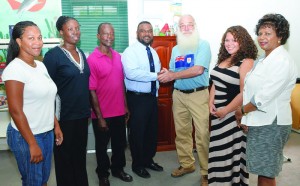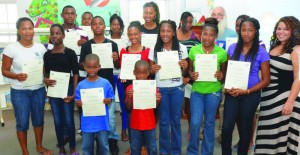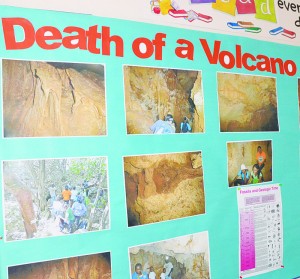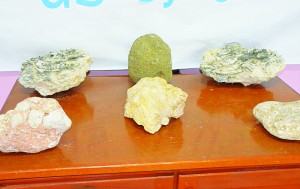



A series of expeditions in Anguilla by a team of geologists and teaching assistants from the University of Puerto Rico, accompanied by students and teachers from Anguilla, have been of much interest and enlightenment for all.
This was expressed on Tuesday, this week, at the Public Library following the conclusion of the expeditions from August 7-12, and the launching of a display of samples and photographs taken at the various sites.The samples comprised minerals, rocks and fossils, caves scenes and underwater photographs.
The visiting team was led by Dr James Joyce and Dr Wilson Ramirez and the expeditions were to Katouche Cave and the sea cliffs and coral reefs on the north coast of Anguilla.
The visiting geologists and teaching assistants were joined by members of the Environmental Club of the Albena Lake-Hodge Comprehensive School and Science Teachers. In addition to the field trips, the students attended lectures on marine geology, the sea cliffs and on the effects of rain water and ground water on the development of caves and sinkholes.
Speaking at the launch of the display, Dr Joyce gave a comprehensive account of the findings of his team. He said that most of the island was tilted towards St Martin/St. Maarten. “That explains why we have sea cliffs on the north side of 100-130 feet and no sea cliffs to the south. Because everything is tilted, the island goes very gently down to the sea. There is not much in terms of sea cliffs [to the south] – just some rocky coasts, generally low.” He also spoke of normal geological faults on the island creating conditions for landslides; of the effects of past volcanic activity and the low coral formation of Anguilla.
Permanent Secretary, Tourism, Foster Rogers, said the geological study of the island was an important undertaking and of much interest to the students and teachers of Anguilla. “This expedition can serve as a catalyst for educational tourism in the future,” he was quoted as saying in an earlier press release. “We understand that the geology of Anguilla is unique in many respects, and that geologists and students of geology, from many universities, will find Anguilla to be a rich study site.”
Anguillian environmental enthusiast, Oliver Hodge, who was also involved in the expeditions, spoke about the interesting features at Katouche Cave which stretches to a distance of three quarters to one mile and a depth of approximately 200 feet. “It is a very beautiful cave,” he reported. “It is a cave you will find challenging. It is not smooth walking, as you have to cross large boulders – and there is quite a bit to see.”
Ms Gina Brooks, of the Ministry of Tourism, was particularly pleased that the geological expeditions were supported by the Anguilla Government and the Office of Governor Christina Scott.
Governor Scott made the following comment in a press release announcing the expeditions: “I am delighted that my office is able to support Anguilla’s first Geo-Science Project. It is a great opportunity for the participants to become familiar with the unique aspects of Anguilla’s geology.”








